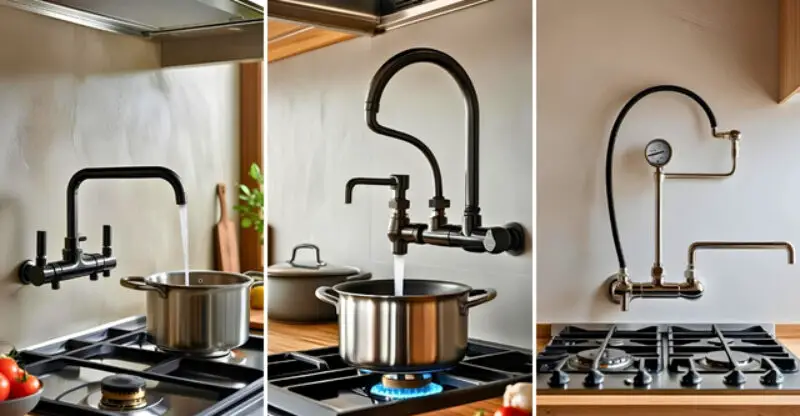What to Consider When Buying a Pot Filler: A Complete Guide
Have you ever seen a fancy faucet over a stove and wondered what it was? That’s a pot filler! It’s a special kitchen tool that makes cooking easier. Instead of carrying heavy pots of water from the sink, a pot filler lets you fill them right on the stove. This can be a huge help, especially when you’re making pasta or soup.
Adding a pot filler can make your kitchen look more professional and feel more convenient. But before you decide to get one, there are a few important things to think about. This guide will help you understand what to look for so you can choose the perfect pot filler for your home. It’s a key part of any kitchen remodel on a budget, adding a touch of luxury without a huge cost.
1. What Style and Finish Should You Choose?
First, think about how you want your pot filler to look. You’ll want it to match the other fixtures in your kitchen, like your main faucet and cabinet handles. Pot fillers come in many different styles, from modern and sleek to classic and ornate. Think about the overall theme of your kitchen. Is it a cozy farmhouse style or a clean, simple modern look?
The finish is just as important as the style. Popular choices include chrome, stainless steel, brushed nickel, and matte black. If you have stainless steel appliances, a matching pot filler can create a cohesive look. For a bolder statement, you could choose a contrasting finish like oil-rubbed bronze or brass. According to design experts at Better Homes & Gardens, matching your pot filler to your cabinet hardware is a great way to tie the room together.
Remember that some finishes are easier to keep clean than others. For instance, a brushed finish can hide fingerprints better than a shiny chrome one. Keeping your fixtures clean is important for a beautiful kitchen, and it’s helpful to know how to clean kitchen faucet head without vinegar to maintain its look over time.
2. Wall-Mount vs. Deck-Mount: Which is Right for You?
Next, you need to decide where the pot filler will be attached. There are two main types: wall-mounted and deck-mounted. A wall-mounted pot filler is the most common type. It comes out directly from the wall behind your stove. This is a great option because it stays out of the way and has a long, foldable arm that can reach all your burners.
A deck-mounted pot filler is installed on your countertop, usually next to the stove. This can be a good choice if you have one of the best undermount kitchen sinks for quartz countertops nearby or if your stove is on a kitchen island. Deck-mounted models are less common and might be a better fit for unique kitchen layouts, especially in homes with small kitchen island ideas that inspire.
The choice between wall-mount and deck-mount often depends on your kitchen’s plumbing. A wall-mounted faucet requires a water line to be run in the wall behind your stove. If you are building a new kitchen or doing a major renovation, this is easier to plan for. A deck-mounted version needs plumbing under the counter. A professional plumber can help you figure out the best and most cost-effective option for your space.
3. Getting the Height and Reach Just Right
One of the most important things to consider is the placement of your pot filler. You need to make sure it’s high enough to fit your tallest pot underneath it, but not so high that it splashes water everywhere when you turn it on. A good rule of thumb, as suggested by kitchen specialists at Riverbend Home, is to measure your tallest stockpot and add an inch or two for clearance.
The reach of the faucet is also crucial. A pot filler has an articulated arm that folds and extends. You’ll want to choose one that can easily reach both the front and back burners on your stove. Before buying, measure the distance from the wall to your front burners to ensure the faucet’s arm is long enough.
Most pot fillers have two shut-off valves for safety—one at the wall and one at the spout. This is a key feature to prevent leaks. It’s much safer than a standard faucet because you have double the protection against drips. This design is different from a pre rinse kitchen faucet, which is designed for powerful cleaning at the sink.
4. Thinking About Installation and Plumbing
Finally, don’t forget about the installation process. Installing a pot filler is not a simple DIY project unless you have plumbing experience. It involves running a new cold water line to the location above or next to your stove. This often means opening up a wall to install the pipe and then patching and finishing the drywall afterward.
Because of the complexity, it’s highly recommended to hire a licensed plumber for the job. A professional will ensure the installation is done correctly and meets all local building codes. They can also help you avoid common problems, like leaks inside the wall, which can be very expensive to fix. As plumbing experts often state, proper installation is key to preventing future issues.
When planning your budget, be sure to include the cost of installation, not just the price of the faucet itself. Getting a quote from a plumber beforehand will help you understand the total cost involved. This planning will ensure your new kitchen feature is a source of convenience, not a headache.
Conclusion
A pot filler can be a wonderful and practical addition to any kitchen. It adds a touch of luxury and makes cooking large meals much simpler. By considering the style, type, placement, and installation, you can choose a pot filler that perfectly fits your kitchen and your needs. Taking the time to plan will help you enjoy this convenient feature for many years to come.



